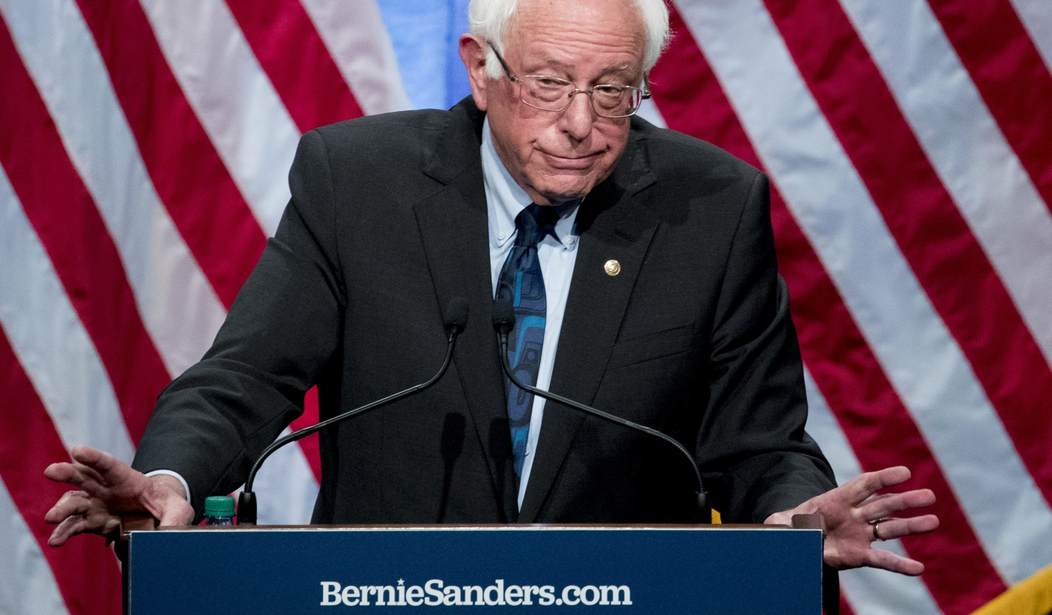On Monday, Sen. Bernie Sanders (I-Vt.), a candidate for the 2020 Democratic presidential nomination, announced his plan to eliminate student loan debt. The plan is perplexing, since it eliminates the debt of everyone, including the wealthy, and aims to finance this absurd proposal by taxing investments in stocks and bonds, harming retirement investments. Yet the plan makes sense as a campaign tactic when contrasted with the plan proposed by Sen. Elizabeth Warren (D-Mass).
“This is truly a revolutionary proposal which accomplishes three major goals,” Sanders said in a statement on the bill. “First, in a highly competitive global economy, it makes certain that all Americans, regardless of income, can get the college education or job training they need to secure decent paying jobs by making public colleges, universities and trade schools tuition-free and debt-free.”
“Second, in a generation hard hit by the Wall Street crash of 2008, it forgives all student debt and ends the absurdity of sentencing an entire generation to a lifetime of debt for the ‘crime’ of getting a college education. Third, it pays for these proposals by implementing a tax on Wall Street speculators. In 2008, the American people bailed out Wall Street. Now, it is Wall Street’s turn to help the middle class and working class of this country,” Sanders declared.
Yet Warren’s plan arguably fits far-left goals in a more reasonable way, including many of Sanders’ goals without some of their drawbacks.
Warren’s less ambitious plan would cost $1 trillion, would eliminate some or all student debt for about 95 percent of borrowers — 42 million people, according to her campaign — canceling up to $50,000 for every person with a household income of less than $100,000. She intends to introduce legislation to this effect with Rep. James E. Clyburn (D-S.C.).
Sanders’ plan is more ambitious in many ways. First, it would forgive the student debts of nearly 45 million graduates — which alone would cost about $1.6 trillion — and eliminate tuition and fees at public four-year institutions and community colleges. It would cap student loan interest rates, expand Pell grants, and cancel tuition at trade schools and apprenticeships. It also has an intersectionality component: sending more money to historically black colleges and universities, tribal colleges, and other such institutions.
Sanders’ plan more than doubles the cost of Warren’s — at $2.2 trillion. In order to pay this sum, he would impose a “Wall Street speculation tax” on financial investment transactions, namely stocks and bonds.
Sanders also one-upped Warren in terms of allies in the House of Representatives. Representatives Ilhan Omar (D-Minn.) and Pramila Jayapal (D-Wash.) have introduced the bill in the House, H.R. 3448.
Rep. Alexandria Ocasio-Cortez (D-N.Y.), the face of the new intersectional class of freshmen congresswomen elected in 2018, spoke at a press conference for the bill. She recalled advising a younger woman considering college loans.
“She got into her dream college but her dream college offered her no scholarships, just loans,” Ocasio-Cortez recalled. “She was given no student loan assistance, she was given no scholarships. All of her student aid was presented to her in the form of loans. And she came from a solid middle-class family, she was not exceedingly wealthy. … And she truly felt at 16, 17 years old. She felt that the decision of college was so important that she felt that she needed to consider taking on $250,000 worth of debt to go to college.”
"She got into her dream college but her dream college offered her no scholarships, just loans."
Rep. @AOC shares story of young woman she mentored who faced $250,000 of debt in order to attend her dream college. pic.twitter.com/9oUcfGtbCh
— The Hill (@thehill) June 24, 2019
In these remarks, Ocasio-Cortez was “unintentionally explaining why Bernie’s plan is so ridiculous,” analytical journalist Josh Jordan noted. “It’s not about getting a college education through sensible community colleges or state schools, but about the government paying for the hopes and dreams of everyone at the cost of others.”
AOC unintentionally explaining why Bernie's plan is so ridiculous.
It's not about getting a college education through sensible community colleges or state schools, but about the government paying for the hopes and dreams of everyone at the cost of others. https://t.co/1Pr6Ll0TBk
— Josh Jordan (@NumbersMuncher) June 25, 2019
Or as Townhall’s Katie Pavlich put it, “Not my responsibility to pay for your ‘dream college.’ Your dream, your choice, your debt. Not mine or anyone else’s. It’s called personal responsibility.”
Not my responsibility to pay for your “dream college.” Your dream, your choice, your debt. Not mine or anyone else’s. It’s called personal responsibility. https://t.co/BcplCp3e6y
— Katie Pavlich (@KatiePavlich) June 24, 2019
Unlike Warren’s more restrained proposal, Sanders’ plan is indeed vulnerable to complaints that it aims to finance the hopes and dreams of Americans, even wealthy Americans, at a cost that would indeed harm a broad swath of the country.
Sanders’ proposal sounds great, but it won’t address the real problems of American higher education, as The Wall Street Journal editorial board noted. Ending tuition sounds wonderful, but the true problems include creeping credentialism (more jobs require a bachelor’s degree); mechanisms that treat marketable skills the same as less marketable skills; ever-increasing administrative staffs that take money without providing educational value; and schools that compete for perks driving up costs.
A fact sheet shows how the plan would be funded: a 0.5 percent transaction tax on stocks, a 0.1 percent transaction tax on bonds, and a 0.005 percent transaction tax on derivatives. He would create an offsetting tax credit for people with incomes under $50,000 and couples under $75,000, but the taxing of stocks and bonds would still harm investments and incentivize the wealthiest Americans to consider other options.
But as the WSJ editorial board noted, “There’s no way a financial-transactions tax would pay for this. It could make America’s capital markets less liquid or push traders overseas. By lowering asset values, it would dent every 401(k) and public pension, while raising costs for institutional investors. Mr. Sanders says it would raise $2.4 trillion over a decade, but France’s version failed to meet revenue targets.”
Like Sanders’ health care plan, this seems a pie-in-the-sky promise aimed to increase government intrusion into private life. As with the “democratic” socialist’s State of the Union response last year, his lavish promises are likely to face “technical difficulties.”
Yet the college plan will also weaken Sanders to attacks from Warren, who has been rising in the polls and threatens to win over his base. Warren’s plan is more realistic (although that’s not saying much) and more tailored to help the “99 percent” over the “1 percent.” Warren’s plan is still absurd, but Sanders has achieved the distinction of making it seem more moderate and realistic.
Warren has also refused to adopt the “socialist” label, calling herself a “capitalist” instead. Conservatives will see through this — she supports the Green New Deal and wants big government to remake America’s economy — but it is wiser in campaign terms. Warren is emerging as a “compromise candidate” for the Democratic establishment.
Warren’s star is rising, and Sanders’ college plan is not likely to derail her. Sanders is still ahead in the polls, but Warren is likely to dominate the first debate on Wednesday.
Follow Tyler O’Neil, the author of this article, on Twitter at @Tyler2ONeil.









Join the conversation as a VIP Member